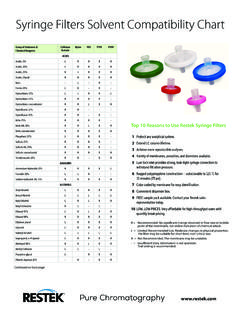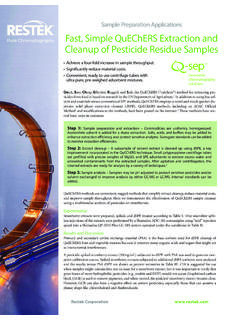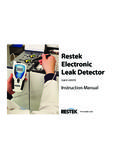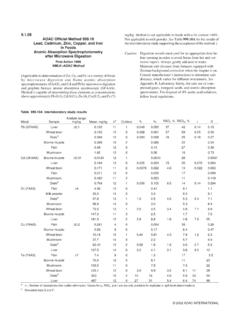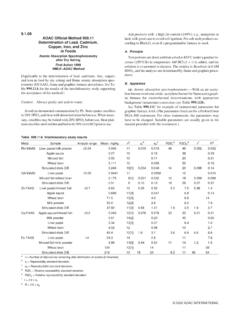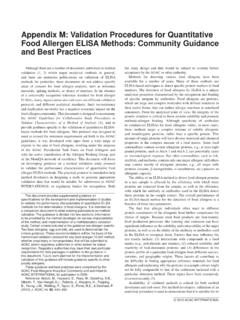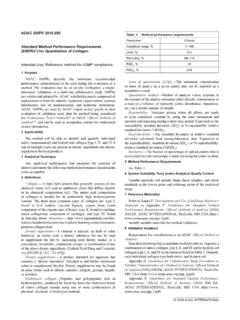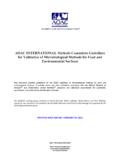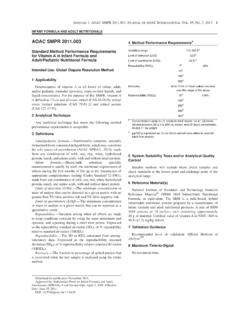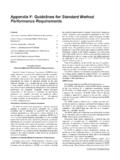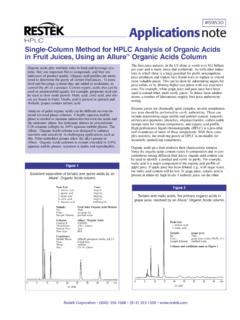Transcription of QuEChERS Methodology: AOAC Method - Restek
1 Quick, Easy, Cheap, Effective, Rugged, and Safe, the QuEChERS ( catchers ) Method is based on work done and published by Anastassiades et al. [1]. QuEChERS was developed using an extraction Method for pesticides in fruits and vegetables, coupled with a cleanup Method that removes sugars, lipids, organic acids, sterols, proteins, pigments, and excess water. This technique offers a user-friendly alternative to traditional liquid-liquid and solid phase extractions. The process involves two simple steps. First, the homogenized samples are extracted and partitioned using an organic solvent and salt solution. Then, the supernatant is further extracted and cleaned using a dispersive solid phase extraction (dSPE) products make this approach even simpler. We offer QuEChERS extraction and dSPE products in a variety of standard sizes and formats.
2 The dSPE centrifuge tube format (available in 2 mL and 15 mL sizes) contains magnesium sulfate (to remove residual water) and primary second-ary amine (PSA) sorbent (to remove sugars and fatty acids). These tubes are available with or without graphitized carbon (to remove pigments and sterols) and/or C18 packing (to remove nonpolar interferences, such as lipids). Several detailed QuEChERS methods have been published and are listed below. Restek Q-sep dSPE tubes, listed in Table I (last page), are formulated according to these methods . Original Unbuffered Method Fast and Easy Multiresidue Method Employing Acetonitrile Extraction/Partitioning and Dispersive Solid-Phase Extraction for the Determination of Pesticide Residues in Produce [1] European EN 15662 Method Foods of Plant Origin Determination of Pesticide Residues Using GC-MS and/or LC-MS/MS Following Acetonitrile Extraction/Partitioning and Clean-up by Dispersive SPE QuEChERS - Method [2] Mini-Multiresidue Method QuEChERS -A Mini-Multiresidue Method for the Analysis of Pesticide Residues in Low-Fat Products [3] aoac Official Method Pesticide Residues in Foods by Acetonitrile Extraction and Partitioning with Magnesium Sulfate [4]Choose a QuEChERS Method based on the commodity and the compounds of interest.
3 The original unbuffered Method is the most simple and works well for many pesticides and matrices; however, it is important to choose a properly buffered Method like EN 15662, mini-multiresidue, or aoac when analyzing pH-sensitive pesticides ( , folpet, chlorothalonil, captan, captafol, pymetrozine, atrazine, tolylfluanid, and dichlofluanid). Buffered methods help control pH during the extraction steps and optimize recovery of acid- and base-sensitive help determining the most suitable QuEChERS Method for your project, please contact Restek technical service at 1-814-353-1300, ext. methodology : aoac MethodQ-sep Packets cat.# 26237 and 26238 General Procedures (common to all QuEChERS -based methods listed above)Step 1: Sample preparation and extraction Commodities are uniformly ground. Internal standards are also added at this point.
4 Various salts, acids, and buffers may then be added to enhance extraction efficiency and protect sensitive 2: Sample extract cleanup A subsample of the modified solvent extract from Step 1 is cleaned up using dSPE. Small polypropylene centrifuge tubes are prefilled with precise weights and proportions of bulk drying salts and SPE sorbent packing to remove excess water and unwanted contaminants from the sample extracts. After a brief agitation and centrifugation, the cleaned extracts are then prepared for 3: Sample analysis Samples may be pH adjusted or solvent-exchanged prior to analysis by either GC-MS or LC-MS. 2 QuEChERS ProcedureThe procedures below are based on aoac Official Method [4]. For complete information, refer to the original source Method available from aoac Extraction1. Homogenize the commodity to generate a uniform sample representative of the product (Figure 1).
5 2. Weigh 15 g of homogenized product into a clean 50 mL tube (cat.# 26239) as shown in Figure Add 15 mL of 1% acetic acid in acetonitrile (v/v) and an appropriate amount of an internal standard Drying and Buffering1. Use one Q-sep aoac Method packet (cat.# 26238) for each extracted sample. Contents are listed below. g g magnesium sulfate, anhydrous g g sodium acetate, anhydrous2. Tap the packet on a flat surface or shake the packet to ensure the salts are at the bottom of the packet (Figure 3).3. Open the packet by tearing straight across at the precut slit (Figure 4).4. Pinch the packet to form an opening. Tilt the packet over the tube and insert the top of the packet approximately 1 inch into the top of the tube (Figure 5). 5. Tap the bottom of the packet to ensure all of the salts have been poured into the extraction tube (Figure 6).
6 6. Immediately vortex or shake vigorously by hand for 1 SeparationCentrifuge for 1 minute at >1,500 rcf to separate the solid material (Figure 8). Proceed with dSPE sample cleanup or analyze extract directly without cleanup. The Q-sep 3000 centrifuge shown here (110 V, cat.# 26230; and 220 V, cat.# 26231) meets or exceeds original unbuffered, aoac , and European QuEChERS methods requirements and supports 50 mL, 15 mL, and 2 mL centrifuge 8 Figure 1 Figure 2 Figure 7 Vortex or shake vigorously by hand for 1 3 Figure 4 Figure 5 Figure 6 3dSPE Sample CleanupThe sample can be analyzed directly from the raw extract, especially if pesticides with acidic groups ( , phenoxyacid herbicides) are of interest. Alternatively, sample cleanup methods can be applied. Specifically, dispersive solid phase extraction is discussed here.
7 Restek Q-sep dSPE tubes are formulated in accordance with published methods and are listed in Table I. Select tubes based on the Method and sample type; general guidelines for different sample types include: References [1.] M. Anastassiades, Lehotay, D. Stajnbaher, Schenck, Fast and easy multiresidue Method employing acetonitrile extraction/partitioning and "dispersive solid-phase extraction" for the determination of pesticide residues in produce. J. aoac Int. 86 (2003) 412-431. [2.] EN 15662, Foods of Plant Origin Determination of Pesticide Residues Using GC-MS and/or LC-MS/MS Following Acetonitrile Extraction/Partitioning and Clean-up by Dispersive SPE QuEChERS Method , 2008. [3.] QuEChERS -A Mini-Multiresidue Method for the Analysis of Pesticide Residues in Low-Fat Products, 2004. [4.] aoac Official Method , Pesticide Residues in Foods by Acetonitrile Extraction and Partitioning with Magnesium Sulfate, 2007.
8 9 Figure 11 Figure 12 Figure 10 For samples with co-extracted fats or waxes: Before or after cleanup, samples are put in freezer (>1 hr to overnight). Cold samples are then recentrifuged and fats or waxes are removed. If fat remains, clean up with 50 mg PSA, 150 mg MgSO4, and 50 mg C18 per mL of extract. If no fat remains, clean up with 50 mg PSA and 150 mg MgSO4 per mL of samples with remaining fats: Clean up with 50 mg PSA, 150 mg MgSO4, and 50 mg C18 per mL of extract (see above).For samples with intensely colored extracts:Clean up with 50 mg PSA, 150 mg MgSO4, and 50 mg graphitized carbon per mL of samples with less intensely colored extracts, or high carotinoid or chlorophyll levels:Clean up with 25 mg PSA, 150 mg MgSO4, and mg graphitized carbon per mL of all other samples: Clean up with 50 mg PSA and 150 mg MgSO4 per mL of extract.
9 Once tubes are selected, dSPE sample cleanup can be accomplished according to the procedure shown Using the centrifuged extracts resulting from the phase separation stage of sample extract preparation, transfer the supernatant to the dSPE tube as shown in Figure 9. Use Table I to determine the volume of sample that should be transferred. 2. Vortex or shake vigorously by hand for 30 seconds or 2 minutes (Figure 10). Use Table I to determine the suggested shake Centrifuge for 1 minute at >1,500 rcf to separate the solid material (Figure 11). 4. Transfer sample to an autosampler vial and test using GC or LC methods (Figure 12). Additional steps to prepare the sample for specific types of analysis are addressed in aoac Official Method [4].Note: To determine the amount (mg) of PSA, MgSO4, and graphitized carbon, use the suggested number of milligrams and multiply by the number of mLs you want to extract.
10 2015 Restek Corporation. All rights reserved. Printed in the #805-01-002 Rev. date: 09/15 ARestek patents and trademarks are the property of Restek Corporation. (See for full list.) Other trademarks in Restek literature or on its website are the property of their respective owners. Restek registered trademarks are registered in the and may also be registered in other about this or any other Restek product? Contact us or your local Restek representative ( ).TSCD trisodium citrate dihydrateDHS disodium hydrogen citrate sesquihydrateNaOAc sodium acetateSorbent GuideSorbent RemovesPSA* sugars, fatty acids, organic acids, anthocyanine pigmentsC18 lipids, nonpolar interferencesGCB** pigments, sterols, nonpolar interferences*PSA primary and secondary amine exchange material**GCB graphitized carbon blackTable I: Restek Q-sep dSPE tubes (organized by published Method ).



